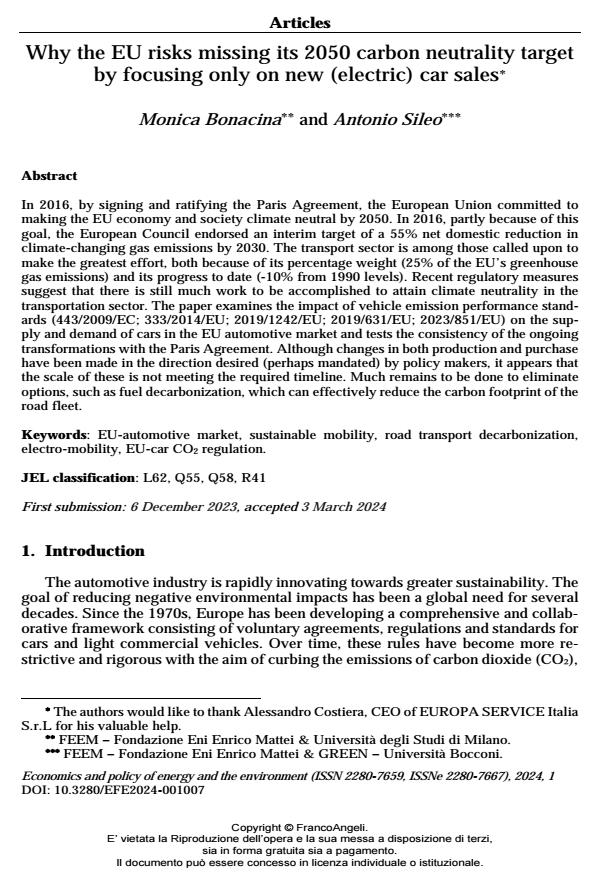Why the EU risks missing its 2050 carbon neutrality target by focusing only on new (electric) car sales
Titolo Rivista ECONOMICS AND POLICY OF ENERGY AND THE ENVIRONMENT
Autori/Curatori Monica Bonacina, Antonio Sileo
Anno di pubblicazione 2024 Fascicolo 2024/1
Lingua Inglese Numero pagine 18 P. 97-114 Dimensione file 256 KB
DOI 10.3280/EFE2024-001007
Il DOI è il codice a barre della proprietà intellettuale: per saperne di più
clicca qui
Qui sotto puoi vedere in anteprima la prima pagina di questo articolo.
Se questo articolo ti interessa, lo puoi acquistare (e scaricare in formato pdf) seguendo le facili indicazioni per acquistare il download credit. Acquista Download Credits per scaricare questo Articolo in formato PDF

FrancoAngeli è membro della Publishers International Linking Association, Inc (PILA)associazione indipendente e non profit per facilitare (attraverso i servizi tecnologici implementati da CrossRef.org) l’accesso degli studiosi ai contenuti digitali nelle pubblicazioni professionali e scientifiche
In 2016, by signing and ratifying the Paris Agreement, the European Union committed to making the EU economy and society climate neutral by 2050. In 2016, partly because of this goal, the European Council endorsed an interim target of a 55% net domestic reduction in climate-changing gas emissions by 2030. The transport sector is among those called upon to make the greatest effort, both because of its percentage weight (25% of the EU’s greenhouse gas emissions) and its progress to date (-10% from 1990 levels). Recent regulatory measures suggest that there is still much work to be accomplished to attain climate neutrality in the transportation sector. The paper examines the impact of vehicle emission performance stand- ards (443/2009/EC; 333/2014/EU; 2019/1242/EU; 2019/631/EU; 2023/851/EU) on the sup- ply and demand of cars in the EU automotive market and tests the consistency of the ongoing transformations with the Paris Agreement. Although changes in both production and purchase have been made in the direction desired (perhaps mandated) by policy makers, it appears that the scale of these is not meeting the required timeline. Much remains to be done to eliminate options, such as fuel decarbonization, which can effectively reduce the carbon footprint of the road fleet.
Parole chiave:EU-automotive market, sustainable mobility, road transport decarbonization, electro-mobility, EU-car CO2 regulation
Jel codes:L62, Q55, Q58, R41
Monica Bonacina, Antonio Sileo, Why the EU risks missing its 2050 carbon neutrality target by focusing only on new (electric) car sales in "ECONOMICS AND POLICY OF ENERGY AND THE ENVIRONMENT" 1/2024, pp 97-114, DOI: 10.3280/EFE2024-001007